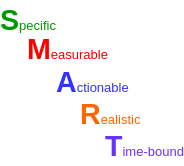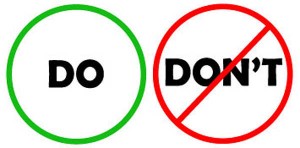Let’s start with a cliché. Our protagonist, Asha, is usually untidy, leaving her backpack on her bed and throwing her shoes in the middle of the hall after she comes back from work. Usually one of her socks finds its way under the furniture. A few pens spill out of the half open zipper of her backpack and fall on the bed. Asha has a hard time clearing out her bed every night she wants to sleep and an even harder time finding a matching pair of socks when she is in a hurry to leave for work. She is irritable and often harasses her mom to find her things for her.
Bunty wants to shed that extra fat from his tummy. He has enrolled for the gym and goes occasionally. But most of the time, life happens and Bunty either finds himself overeating while celebrating with friends or not going to the gym because he has something else to do. Even at the gym, he ambled around from machine to machine, getting a few reps, but doing anything effective.
On new year’s eve, both Asha and Bunty set resolutions. They vow to get tidy and get trim respectively. For the first week, everything works great. But, just after a week, things are back to what they were. Asha’s shoes are in the hall and Bunty is binging on extra large pizza, not having gone to the gym for two days.
How can we help Asha and Bunty stick to their resolutions? There are many solutions, but some of them work better than the others. My favourite is a method that political parties, engineering standards organisations and committees follow religiously. Writing and referring to a manifesto.
Tried and tested solutions
Let’s start with some tried and tested solutions. We are tapping into the knowledge practised by several successful people around the world.
- Set SMART goals: SMART stands for Specific, Measurable, Achievable, Relevant and Time-bound.

- Your goal has to be Specific: Instead of ‘I will be thinner’, you should say ‘My target waist size is 30.’
- Your goal has to be Measurable: You should be able to measure at periodic intervals. You should know where you stand and how much you need to go. E.g. ‘My target is to run 12 km in an hour. Today I can run 10. To get there, I need to complete each kilometre in 5 minutes instead of the 6 I take today.’
- Your goal has to be Actionable: Every goal should have a vivid action as the verb. There should be no vague verbs like ‘Be’, ‘Try’, ‘Take’, ‘Do’, etc. So instead of ‘Be a good and consistent writer’, switch to ‘Write 100 blog posts this year’.
- Your goal has to be Reasonable: The specifics set should not be too easy, but at the same time it should not be completely out of reach or should not spread you too thin. For instance, if you are starting a business, it is reasonable to concentrate on launching one or two products, but not ten products in the first year.
- Your goal has to be Time-bound: Every goal should have a deadline, otherwise it is too easy to procrastinate. Healthy deadlines spur action. E.g. ‘I want to learn to make white sauce penne pasta’ doesn’t motivate you to act today. But ‘I want to learn to make white sauce penne pasta by this weekend’ is great.
SMART goals are discussed in clear detail in Michael Hyatt‘s The beginner’s guide to goal setting.
- Get your Dos and Don’ts correct: While setting goals, people often get caught up in the things that they should be doing. So much so that they forget to set rules on what not to do. It is the things that you shouldn’t do that often takes you several steps back in your goal. Sometimes, the Don’ts completely destroy the effort that you put into your Dos.
 Imagine buying a new suit, wearing it with the perfectly matched shirt and tie, hanging it on a sturdy coat hanger, even following washing instructions to the dot to keep your suit spotlessly clean. But what if you leave your iron in cotton mode instead of nylon mode and melt a hole through the fabric… ouch! A simple two-sided procedure can help you make a comprehensive checklist of things that you should be and shouldn’t be doing.
Imagine buying a new suit, wearing it with the perfectly matched shirt and tie, hanging it on a sturdy coat hanger, even following washing instructions to the dot to keep your suit spotlessly clean. But what if you leave your iron in cotton mode instead of nylon mode and melt a hole through the fabric… ouch! A simple two-sided procedure can help you make a comprehensive checklist of things that you should be and shouldn’t be doing. - Engineer your environment: Most well-intentioned, but ill-experienced goal setters use brute-force, i.e. will power, to force themselves to work on their goals. Will power can run out of steam. Everytime you do something that is against the flow, you lose a little bit of will power, until you finally exhaust it. So why force yourself to work against the flow? Why not keep things in flow? You should design your surroundings such that you are not forced to will your way to your goals. Why keep aromatic cookies on a lower shelf when you shouldn’t be eating them? You shouldn’t buy cookies at all. Your Internet connection should be disconnected when you are writing your book. All reference text should be downloaded offline so that you can refer to them without having to go to the web. Richard Thaler and Cass Sunstein talk about the role of ‘choice architect’ for a person who sets up the odds so that the right choice is made without effort or will power. They call the concept ‘Nudge’.
Fine, so what is a manifesto?
Okay, finally, I will give it to you. Nothing radical. A manifesto is a full text of instructions (and maybe diagrams) that you put together using the above three principles. You either keep it in your computer as a PDF, print it out and leather-bind it or stick it on your wall (neat one-page manifestos on a wall are really effective). Ideally, you should spend some time, at least a week, to prepare as comprehensive a manifesto as you can. Sure, there can be many more additions later when you start putting your manifesto’s content to practice, but a solid start can also kickstart your goal in the right direction. With a manifesto, you are making your yearly goal as specific as possible, breaking it down into smaller specific goals, applying rules for the steps to take and planning your environment. 90% of your manifesto should be made either in the last week of December or the first week of January. You can iron out the manifesto as you start working towards your goals and find new challenges.
But really, why should I write one?
Here are some reasons on why you should write a goal manifesto.
- Writing down your goals and an approach on how you will move towards them makes things clear in your mind. You will discover what you really want and what your favourite approach is.
- The more questions you ask and answer, the less the stumbling blocks and less the chances of procrastination. If you write very specific goals and stringent rules, you will run out of wiggle spaces that can derail your goals.
- Writing a manifesto is a form of commitment. Because you committed to a ‘contract’, you will behave such that you want to honour that contract. Call it ‘standing behind yourself’ or setting an identity for yourself.
- Reading the manifesto every day or even every week crystallises the goal in your mind and changes the way you think. You start thinking more often about your goals and give them prompt attention, almost in everything you do.
Do you write one?
I am new to this procedure too. I started writing goals only for my 2018 goals.
I am not as disorganised as Asha, but I would still like to be super-organised. While I don’t throw my shoes and socks around the house, I still have trouble remembering to return books to their shelves or clothes hung out to dry to their closet. To put me on the right track, I am writing a manifesto to practise Mise en place, the art of “A place for everything and everything in its place”. My promise to myself is that if I want anything around the house, say a safety-pin or a knife or my socks, I should know exactly where to find it and have it ready to use in less than a minute.
Fascinated by all the culture around India that we are seeing in our trip India 360, I realise that the best way to interact with locals is through their own language. Hence I have set a new goal to learn three major Indian languages every year for the next six years. This should cover all the major languages in India. However, it is not easy to learn a new language unless you have a plan on how to learn it. Hence comes my language manifesto, that I am preparing steadily.
Can you give me an example?
I’ll give you two. Here are some lines from my ‘Mise en place’ manifesto.
- We have four types of things around the house: objects, working surfaces, storage units and carriage units. Objects are things that we use for our work. Working surfaces are the ideal places where the objects are when in use. Storage units are places where objects should be stowed away when not in use. Carriage units are things in which objects are carried from one place to another.
E.g. A pen (object) belongs to the pen holder (storage unit) on my book shelf’s second row from top. I often bring it to my desk (working surface) when I need to write. I often clip my pen to the pocket of my shirt (carriage unit) while I carry it to the desk. I purchase fruits (objects) in cloth / plastic bags (carriage units) and transfer them to the fridge (storage unit). - If an object is not in use at a working surface for more than half-an-hour, please return it immediately to its storage unit. E.g. a pen lying on the desk for more than half an hour should be paid due attention and returned to the pen holder. Working surfaces should not be used as storage units.
- Never leave things in their carriage units. They often clutter space really fast. E.g. a cloth bag of fruits will keep lying around on your kitchen counter and hamper your space when you want to cook. Carriage units are not for storage. Assign storage units immediately and put things there. Likewise, a pen clipped to your pocket will not be remembered or found quickly. You will waste precious time looking for your pen. Return the pen to the pen stand as soon as you are done with it.
Here are some sample lines from my ‘Language Learning’ manifesto.
- Learn all the characters in the language. These should include all the consonant sounds (t, d, k, g, ch, th, s, sh, etc) and all the vowel sounds (a, aa, i, ee, e, ai, u, oo, o, etc).
- Skim through the English newspaper for possible vocabulary words that you want to learn in your target language. The words should be categorised into categories such as travel, food, transport, politics, etc. Learn those words in the target language. Grammatically, the words should be classified as nouns (with genders), verbs, adjectives and adverbs.
- Imagine that you are standing in the middle of a large cube, facing one of the faces of the cube. You should be able to point to the 6 faces of the cube and say the following words in the language you are learning: front, back, up, down, left, right, edge, corner. You should also be able to point from inside the cube and identify north, south, east and west.
- Learn numbers, ordinals, fractions and decimals.
- Learn to say the time in hours and minutes. Also learn AM or PM and whether it is morning, noon, afternoon, evening, night or mid-night.
- Never translate phrases word-for-word from one language to another. Learn the correct phrase in the target language. Also translate that phrase into English literally so that you find it visual and easy to remember. E.g. in French, you do not say, ‘How old are you?’. A Frenchman would take offence and accuse you of calling him old! You always ask the equivalent of ‘Which age do you have?’
Of course, the above lines are only small extracts from my manifesto. I have detailed more such specific actionable steps and concepts.
Just think for a moment about the results of such as manifesto. I have classified everything in my home into four categories and set both DO and DON’T rules around them. To my previous self, things were just things. But the more I read the manifesto, the more my mind will start classifying everything into the four categories and think about the rules. Finally, the more likely I am to put things in their places until it becomes a habit. By making a language manifesto, I am ready to learn any language with reasonable competence.
How much is too much?
You are diving too deep into your manifesto if it takes you more than a week to get started taking action. Spend only one week. Start doing things from the next week. One week’s worth of manifesto is usually enough to start your goal. It is probably good enough for 90% of your challenges. Beyond that, you should probably spend 30 minutes every week to expand on or alter the points in your manifesto. For example, I skim a newspaper only once a week for half an hour to mark new words in the manifesto for vocabulary.
Conclusion
If you have been trying to stay on top of your goals and new year resolutions, maybe putting things in writing in a manifesto is the boost you need to get motivated and start taking action. But you don’t need to wait for new year’s eve. Try it today.
